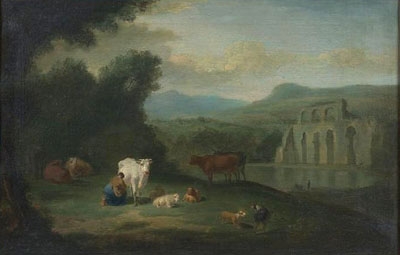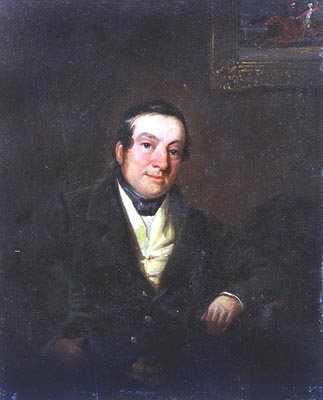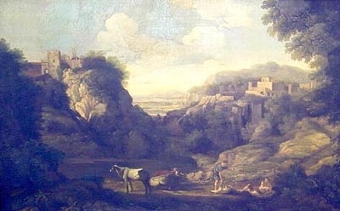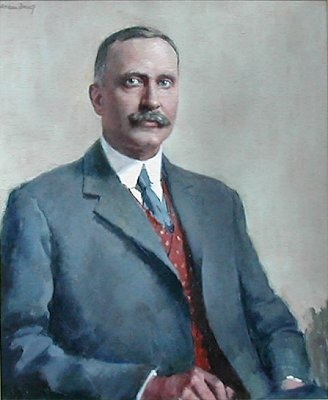featured item
an italianate pastoral landscape with a milkmaid and cattle with ancient ruins
- View other items in:
- antiques interior design modern and vintage
- other interior design
artware ltd
Enquire about this antique
Artware Ltd has 565 antiques for sale.
click here to see them all
Philip James de Loutherbourg, also seen as Philippe-Jacques and Philipp Jakob and with the appellation the Younger (31 October 1740 ? 11 March 1812) was an English artist of French origin. He was born in Strasbourg, where his father, the representative of a Swiss family, practised miniature painting; but he spent the greater part of his life in London, where he was naturalized, and exerted a considerable influence on the scenery of the English stage, as well as on the artists of the following generation. De Loutherbourg was intended for the Lutheran ministry, and was educated at the University of Strasbourg. As the calling, however, was foreign to his nature, he insisted on being a painter, and placed himself under Charles-Andr? van Loo in Paris. The result was an immediate and precocious development of his powers, and he became a figure in the fashionable society of that day. In 1767 he was elected into the French Academy below the age required by the law of the institution, and painted landscapes, sea storms, battles, all of which had a celebrity above those of the specialists then working in Paris. His debut was made by the exhibition of twelve pictures, including Storm at Sunset, Night, Morning after Rain.
He is next found travelling in Switzerland, Germany and Italy, distinguishing himself as much by mechanical inventions as by painting. One of these, showing quite new effects produced in a model theatre, was the wonder of the day. The exhibition of lights behind canvas representing the moon and stars, the illusory appearance of running water produced by clear blue sheets of metal and gauze, with loose threads of silver, and so on, were his devices. In 1771 he came to London, and was employed by David Garrick, who offered him ?500 a year to apply his inventions to Drury Lane, and to superintend the scene-painting, which he did with complete success, making a new era in the adjuncts of the stage. Garrick''s own piece, the Christmas Tale, and the pantomime, 1781-1782, introduced the novelties to the public, and the delight not only of the masses, but of Reynolds and the artists, was unbounded. The green trees gradually became russet, the moon rose and lit the edges of passing clouds, and all the world was captivated by effects we now take little notice of. A still greater triumph awaited him on his opening an entertainment called the Eidophusikon, which showed the rise, progress and result of a storm at sea that which destroyed the great Indiaman, the Halsewell,and the Fallen Angels raising the Palace of Pandemonium. De Loutherbourg has been called the inventor of the panorama, but this honor does not belong to him, although it first appeared about the same time as the eidophusicon. The first panorama was painted and exhibited by Scottish painter Robert Barker.
All this mechanism did not prevent De Loutherbourg from painting. Lord Howe''s Victory off Ushant (1794), and other large naval pictures were commissioned to commemorate British naval victories, many of them ending up soon afterwards in the Greenwich Hospital Gallery (in whose successor, the National Maritime Museum, they still remain). His finest work was the Destruction of the Armada. He painted also the Great Fire of London, and several historical works, one of these being the Attack of the Combined Armies on Valenciennes (1793). He was interested in the industrial revolution and his 1801 painting Coalbrookdale by Night shows iron foundries at work. He was made a member of the Royal Academy, in addition to other distinctions, in 1781, shortly after which date we find an entirely new mental impulse taking possession of him. He joined Balsarno, comte de Cagliostro, and travelled about with this extraordinary person leaving him, however, before his condemnation to death. We do not hear that Mesmer had attracted De Loutherbourg, nor do we find an exact record of his connection with Cagliostro. A pamphlet published in 1789, A List of a few Cures performed by Mr and Mrs De Loutherbourg without Medicine, shows that he had taken up faith healing, and there is a story that a successful projection of the philosopher''s stone was only spoiled by the breaking of the crucible by a relative. He died in 1812.
His publications are few ? some sets of etchings, and English Scenery (1805).
Antiques.co.uk Ref: U2T4886W
- Materials:
- Oil on Canvas
- Width (cm):
- 40.64 x 63.50 cm 16.00 x 25.00 ins
Artware Ltd
Artware Fine Art specialises in fine antique, decorative and historical portraits and topographical pictures . We cover a period from the 17th and 18th centuries through to the 19th & 20th Centuries. We have over 150 portraits in stock, which can be viewed on our web site, each historical portrait has well researched biographical information both on the sitter and the artist.
Contact details
18 La gare
51 Surrey row
London
Greater London
SE1 0BZ
UNITED KINGDOM
T: 0207 921 97904
E: greg@artwarefineart.com
W: www.artwarefineart.com












